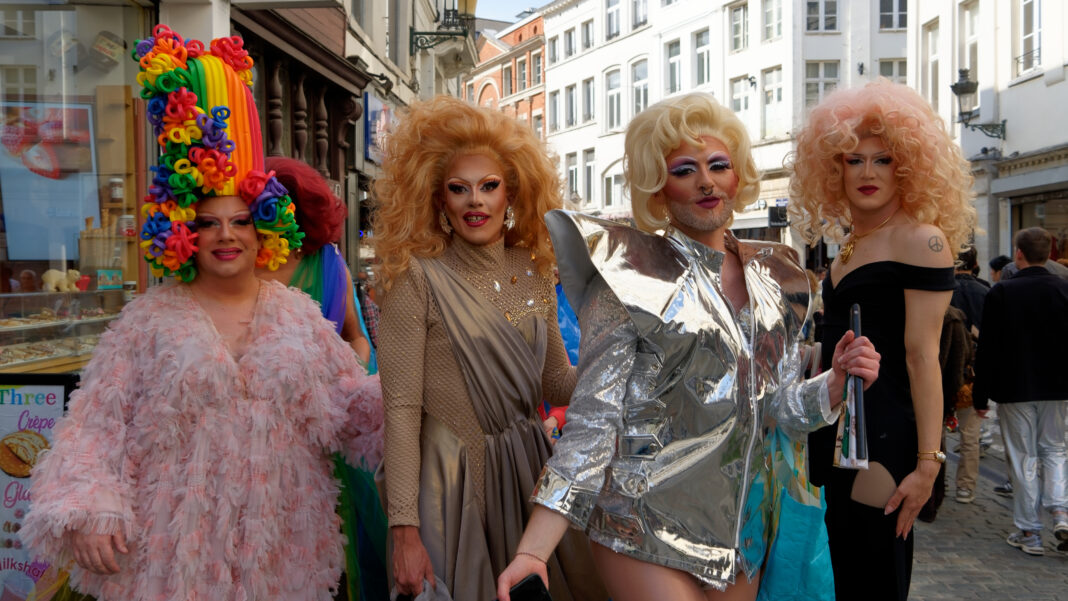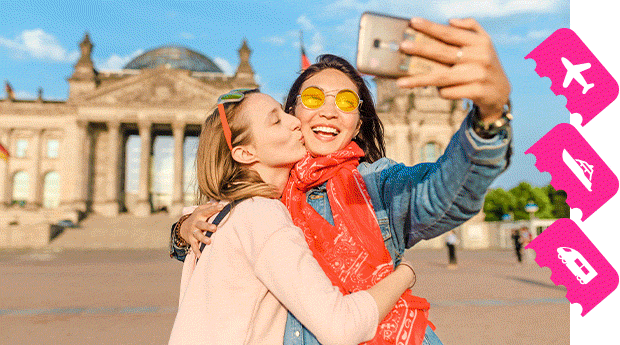Brussel sprouts. Waffles. Chocolate. The home of the European Commission, the Council of the European Union and the European Council. Stereotypes about Brussels seem built mostly on tasty food and bureaucracy. Oh, and the Manneken Pis statue of a boy urinating into a fountain. Provisions, paperwork and pee.
Brussels, which has a metro population of about 2.14 million, doesn’t have the iconic landmarks or famed beaches as some other queer European destinations. Yet the capital of Belgium and the de facto capital of the European Union has lots for LGBTQ+ visitors.
Planted amid the languid hills and glassy waterways of northern Belgium, Brussels is a multicultural city and a deeply queer hub of art, food and style.
It’s also eccentric. In lieu of the Eiffel Tower, Brussels boasts the Atomium, a molecule-shaped steel titan that survived the 1956 World Expo and still dominates the Brussels skyline. Instead of a Statue of Liberty, there’s a statue of the singer Jacques Brel on Place de la Vieille Halle aux Blés. Meanwhile, there are not one but three statues of mammals peeing: the aforementioned Manneken Pis; the girl, Jeanneke Pis; and the dog, Het Zinneke.
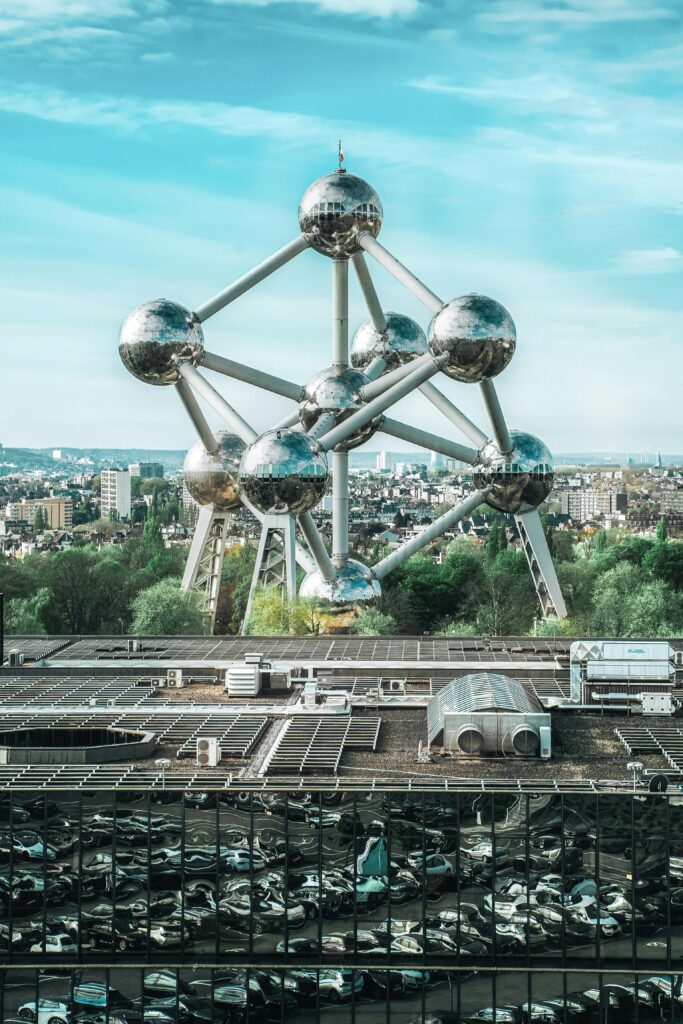
And who needs the Sistine Chapel when there’s Brussels’ Sewer Museum? Just kidding. But Brussels’ museums dedicated to the surrealist Magritte, Tintin creator Hergé, comic books and even musical instruments are worth the trip for art and culture nerds.
It’s perhaps unsurprising that such an artsy and peculiar city is also welcoming to queers. In fact, Belgium is one of the world’s most LGBTQ+-friendly countries: In 2003, it became only the second country in the world to legalize same-gender marriage. Adoption for same-gender couples has been on the books since 2004, while legal recognition of gender changes have been around since 2007 if surgery is involved; in 2018, surgery was no longer a requirement for recognition. Brussels Pride, usually held in May, is a politically vibrant cherry on top.
Indeed, queerness rears its head all around the city, fostering a relaxed and playful subculture of rainbow fabulousness. There seem to be no boundaries between where the queerness stops and the straightness begins. Queerness spills out into the streets, notably on electropop dance floors, in falafel queues, and at temporary art exhibitions and late-night drag shows. There’s RainbowHouse (Rue du Marché au Charbon 42, Brussels), a community centre planted in the heart of the city where queer activism and cultural exchange take place. There are also iconic parties like La Demence and bustling bars like Le Baroque (Rue du Marché au Charbon 44, Brussels), both of which draw international crowds. There’s even a strong undertone of kink and alternative culture here; some spaces are lovingly dedicated to leather and latex.
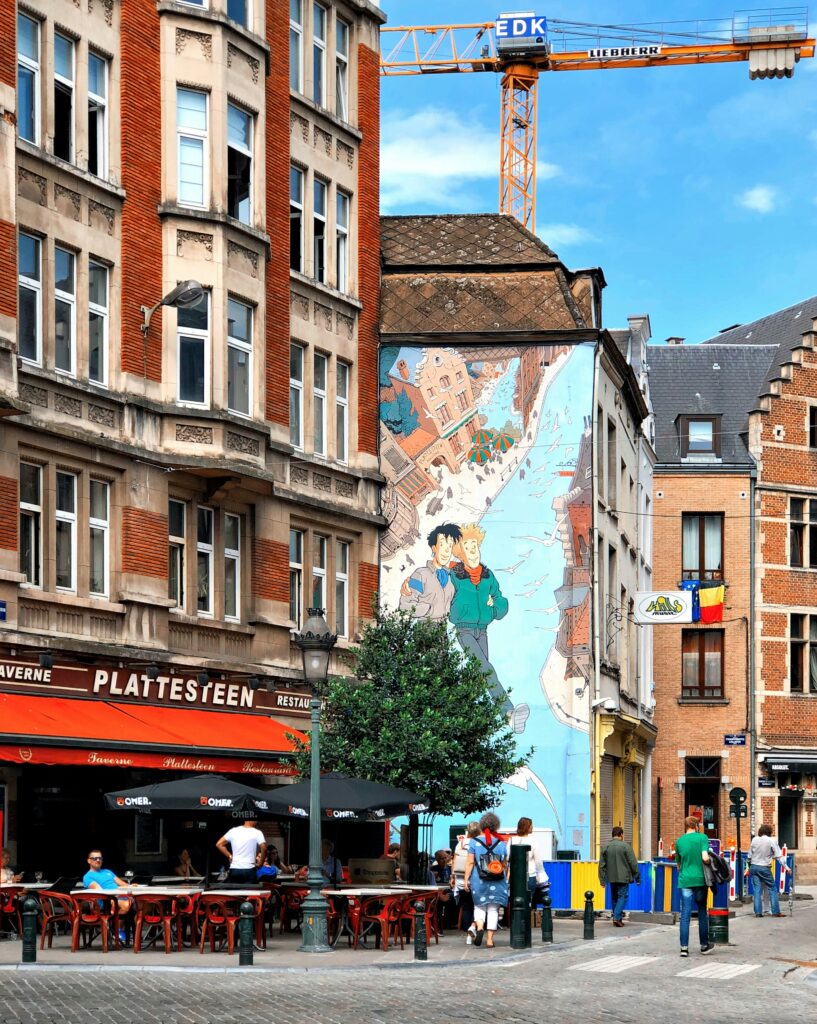
Saint-Jacques, near the city’s historic centre, is Brussels’ closest thing to a gaybourhood; it remains buzzy and welcoming far beyond Pride season. But there are lots of neighbourhoods worth exploring. Ixelles, just a 30-minute walk away, is Brussels’ answer to Brooklyn (well, the Brooklyn of 10 to 15 years ago): stylish, multicultural, chic and full of independent boutiques. The French-speaking hipsters here sip pét-nat (sparkling wine). Saint-Gilles, on the other hand, is bohemian without being performative. It’s grungy and interesting with its smoky, mural-covered cafés and vinyl shops that double as falafel stands. Beyond the average tourist’s radar is Schaerbeek, where intense creatives and queer migrants carve out lives of art, music and joie de vivre.
Brussels also has a lot on hand for foodies. Pralines were born here (the Belgian kind, not the equally delicious Southern U.S. variety). French fries, too, first appeared in Belgium, and are the star of the national dish, moules frites. Belgium is, of course, known for its beer. Delirium Café (Imp. de la Fidélité 4, Brussels) once held the Guinness World Record for having the largest number of beers commercially available. Even the non-alcoholic options in Brussels are exquisite, and pair well with anything you’ll find at a fritkot (fries stand).
For foodies who prefer not to stand and munch, there are numerous global goodies available: Congolese stews, Vietnamese street food, Moroccan pastries, Michelin-starred French restaurants. Basically, everything one might expect from the “Capital of Europe.”
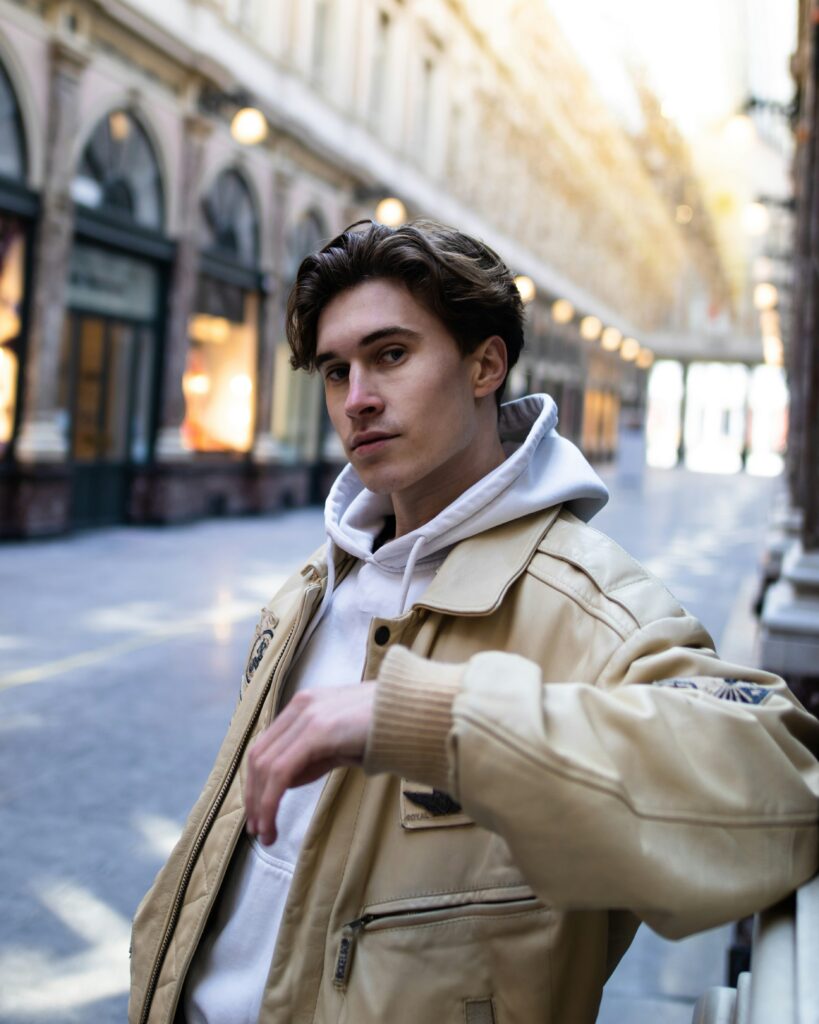
Thankfully, Brussels is easy to navigate for English-speakers. Though French is the predominant tongue, with Dutch as the lingua franca farther north, English remains the functioning primary language of Europe and its capital. Still, a friendly “bonjour” goes a long way, and the Bruxellois, like the French, appreciate effort over fluency.
Even if the locals appear reserved at first, they will eventually open up without much ado and invite you to their favourite dive bar. Just don’t ever admit that their city used to only make you think of Brussels sprouts. That statue of the little peeing boy, on the other hand, is fair game. They’re pretty proud of him. Here is the rest of the best of LGBTQ+ Brussels.
Pride
Brussels Pride (usually held in May; the next one is May 16, 2026). The 2026 edition will celebrate 30 years of Pride. They take it seriously. In 2024, the Brussels-Capital Region added Brussels Pride to its intangible cultural heritage list (along with the Ommegang, chips and comic strips), making it only the second Pride in the world to have such institutional recognition.
What to see and do
The Atomium and Mini Europe (Pl. de l’Atomium 1, Brussels). The actual interior of the giant molecule-shaped Atomium is not worth the 16 euro (US$18) admission fee; a reservation at the panoramic restaurant does not grant access to the exhibits. However, Mini-Europe next door, which features 1:25 scale models of European landmarks, is a surprisingly entertaining homage to each of the European Union’s current and former countries.
Mannekin Pis (corner of Rue de l’Etuve and Rue du Chêne, Brussels). A lot of tourists find this famous statue of a little peeing boy to be disappointing; However, the same can’t be said for those who check out the posted calendar and stop by for the ceremony where serious-faced officials dress him in a new outfit. This little diva owns over 900 different outfits.
The Comics Art Museum (Rue des Sables 20, Brussels). Housed in one of Brussels’ many art nouveau architectural treasures, the Comics Art Museum provides a quick, satisfying romp through the history of comic books. Given that Belgium is also a prolific producer of comics as well as the birthplace of the Smurfs and Tintin, the Comics Art Museum is also a great place to pick up a souvenir graphic novel.
Hergé Museum (Rue du Labrador 26, Ottignies-Louvain-la-Neuve). Located in a suburb outside of Brussels, about an hour by train, this museum is dedicated to the creator of Tintin. Not to start any rumours, but the eternally young reporter never showed as much interest in women as he did in his male friends, including the bear-ish sailor he lived with, Captain Haddock.
La Grand-Place (Grote Markt, Brussels). Immense, bombastic and melodramatic, this city square, surrounded by buildings dating back to the 14th century, forms the historic heart of Brussels. A closer look at the statues that adorn the various shops, hotels and halls in this grand plaza will provide a glimpse into the city’s past, provided one has the right guide.
Magritte Museum (Pl. Royale 1, Brussels). Belgium’s most famous surrealist is on display in all of his glory at this engrossing museum that features his artwork. While his famous “not a pipe” work isn’t in Brussels, his many other captivating pieces are.
The Musical Instruments Museum (Rue Montagne de la Cour 2, Brussels). This one is perfect for bonafide cultural anthropology nerds, but it’s still fascinating for everyone else. Visitors can see and listen to instruments from all around the world.
Where to stay
Brussels Marriott Hotel Grand Place (Rue Auguste Orts, Grand Place 3-7, Brussels). Centrally located across from the delightfully adorned Brussels Stock Exchange, this four-star and certified queer-friendly stay is known for its helpful staff and spotless accommodations.
Aloft Brussels Schuman (Pl. Jean Rey, Brussels). Decked out in neon colours, pop art and plush cushions, Aloft is dressed to impress. This music-themed Marriott brand is also a very queer-friendly design-forward offering that’s close to both public transportation and the European Parliament—perfect for poli-sci nerds.
Hotel Fleur de Ville (Rue du Fossé aux Loups 46, Brussels). Boasting multiple architectural styles and impeccably decorated, this “flower of the city” has a terrific breakfast and a central yet quiet location.
Pillows City Hotel (Parochiaansstraat 15/23, Brussels).Close to the train station and a cult favourite Smurf mural, the Pillows City Hotel offers polished, modern glamour, as well as comfortable rooms.
Thon Hotel Bristol Stephanie (Avenue Louise 91-93, Brussels). This attention-grabbing contemporary-chic mid-budget spot was helpfully built on Brussels’ best shopping street. Its bold yet tasteful décor and on-site French restaurant are standouts.
Where to eat
Le Plattesteen (Rue du Marché au Charbon 41, Brussels). There are a few queer places in Brussels that can claim to be institutions, but none can touch the legacy of this anytime-of-the-day brasserie. Charles Aznavour, Annie Cordy, Jacques Brel, Edith Piaf, Claude François, Charles Trenet, David Bowie and Elvis Costello have been here. It’s also home to the gay mural by Frank Pé that announces to the world that they’re at the heart of the city’s gay village.
Le Kaffabar (Pl. Rouppe 1, Brussels). They don’t roast their beans so much as massage the flavour out of them. The pastries go hand-in-hand with the people-watching at this comfy café. Their adorable mascot is Marcel, a French bulldog.
Le Roi de la Gaufre (Rue de la Fourche 41, Brussels). Those seeking crisped and sugared Belgian waffles, a perfect handheld street food, will find them at this modest shop. Customers can even watch them get made through the display window.
Elisabeth (Rue au Beurre 43, Brussels). No Brussels trip is complete without gorging on pralines. And you could do worse for pralines than Elisabeth. The wide variety of flavours ensures that everyone leaves happy. They have nine locations, including shops in Paris, Bruges and Antwerp.
Comme Chez Soi (Pl. Rouppe 23, Brussels). This renowned century-old restaurant, located in a townhouse just 10 minutes from La Grand-Place, cooks with only the best European ingredients. The Art Nouveau interior lends a timeless elegance to the evening.
Le Chou de Bruxelles (Rue de Florence 26, Brussels). If there’s one place to have mussels in Brussels, it’s here. There are nearly 30 styles to choose from, and each one gets rave reviews.
Where to party
La Demence. As the sweatiest, horniest queer dance party in all of Brussels, La Demence is rightfully legendary among the locals … and beyond. The venues are always changing; some are massive. Check the website to see where the next party takes place.
CAVE (Pl. de la Chapelle 6, Brussels). Plato could never. In this cave, the queers will find electronic music spun by local and international DJs, grungy service and breathless, shirtless men. Underground. Literally.
FLASH Club (Rue Duquesnoy 18, Brussels). There’s only one club that the Brussels crowd goes to on Sunday nights. FLASH delivers all of the pop musical abandon and smoky performances of a typical club, but exclusively on the Christian Day of Rest.
Chez Maman (Rue des Grands Carmes 7, Brussels). When you’re good to Chez Maman, Chez Maman’s good to you. Literally “Mama’s House,” this cabaret bar is the star of Brussels’ drag scene, thanks to its unforgettably dramatic performances.
Cabaret Mademoiselle (Rue du Marché au Charbon 53, Brussels). This drag-cabaret venue caters to fans of burlesque and comedy queens.
Le Baroque (Rue du Marché au Charbon 44, Brussels). If it ain’t Baroque, don’t go there. Well, actually, the other venues on this list are pretty great. But bear lovers, especially, will love this camp bar where the crowd frequently spills out onto the sidewalk.
Station BXL (Rue du Marché au Charbon 27, Brussels). It’s pet-friendly, welcome to all ages, plays retro music videos and there’s even Wi-Fi. What else could you want from this old-school gay bar?
The Agenda (Plattesteen 18/20, Brussels). You are the karaoke queen … young and sweet … only 37. The friendly crowd at this very inclusive queer- and trans-friendly bar will love to hear you belt your heart out. They also host rave parties, games night, talent shows, viewing parties and drag.
La Réserve (Pt Rue au Beurre 2, Brussels). Brussels’ oldest gay bar, which came under new management in 2024, pairs modern music with nostalgic wall-hangings to create a warm communal atmosphere. Bear and leatherman events are held here.
Le Belgica (Kolenmarkt Marché, au Charbon 32, Brussels). A favourite meeting place for queers who are just starting their nights. Its disco balls, cheap drink, DJs and convivial outdoor space all set the right tone.
L’Homo Erectus Bar (Rue du Marché au Charbon 5, Brussels). This bar’s punny name and artsy, feminine décor are perfect accompaniments for its naughty drag shows … and for the saucy sex shop next door.
Where gay and bi guys can find fun
Macho Sauna (Rue du Marché au Charbon 106, Brussels). There are many ways to end a night at La Demence, but Macho Sauna is the first choice for many horny guys. This spacious sauna’s outstanding and well-equipped premises (they’ve got a gym) are conducive to a great time.
Oasis Sauna (Rue Van Orley 10, Brussels). Like its namesake, Oasis provides a serene, aquatic retreat amid the scorching hot party scene of Brussels. Its sauna rooms are perfect for laid-back queers and the daddies who love them.
Stammbar (Rue du Marché au Charbon 114, Brussels). During the day, Stammbar is the cruising bar, complete with slings, cages, a darkroom and plenty of kinky patrons. After 3 a.m., however, it becomes the only bar thanks to its late hours on Fridays and Saturdays. They host jockstrap parties, naked/underwear parties and take their music seriously.
Where to shop
Boris Boy (Rue du Midi 95, Brussels). Boris Boy is the man-loving leather-and-latex fantastical fetish shop that hints at sexual adventures that many guys only dream of. They’ve got poppers, harnesses, singlets.
Spit It Out (Rue du Marché au Charbon 5, Brussels). This companion shop for L’Homo Erectus is a perfect destination for anyone who’s buzzed on Erectus beers and seeking upscale fetishwear. Latex, harnesses, puppy masks—often with a twist.
Be Color (Rue du Lombard 5/9, Brussels). As RuPaul’s Drag Race alum Alyssa Edwards once said, don’t get bitter, just be colour. Or something like that. Anyway, this very queer-friendly gift store is packed with rainbow flair and other bright miscellanea.
Lady Paname (Rue des Grands Carmes 5, Brussels). This women-owned “adult entertainment store” is big and full of secrets. There’s also a refreshing gender balance represented in the toys.
2BE Brussels (Rue du Lombard 29, Brussels). 2BE or not 2BE … That’s the question nobody’s asking, because the answer is always 2BE. Stylish men with a preference for showing their skin will appreciate the bold loungewear, underwear, sportswear and swimwear on sale here.
La Boutique Tintin (13 rue de la Colline, Brussels). If taking the train to the Hergé Museum out in the suburbs seems like too much work, go shopping at this mecca for licensed Tintin bric-a-brac. He’s the most famous forever-single only-hangs-out-with-guys Belgian.
